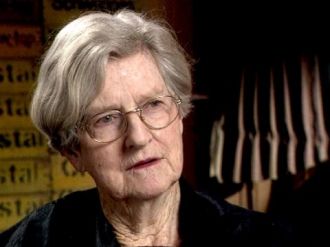Rosalie Gascoigne [My Favorite Photo]
AUSTRALIAN BIOGRAPHY: ROSALIE GASCOIGNE
YEAR:
1999
Rosalie Gascoigne (1917–1999) was interviewed by Robin Hughes for the Australian Biography series when she was 82 years old. Originally from New Zealand, Gascoigne spent much of her adult like in the Canberra/Monaro region. In this interview excerpt she describes her love for the Australian landscape and her process of discovering objects and materials. She fossicks for 'weathered, battered old things' to use in her artistic practice, finding the countryside 'confirming and exciting'. 'Anything could happen you see. It's marvellous. It's a wonderful freedom.' She explains that she's on the look out for vitality - the source of life - in the things she finds. She talks about how past experiences get woven into each work - 'It's not about how it looks it's about how you feel about it'.
Beginning her artistic career when she was in her fifties, Gascoigne is best known for her poetic assemblages of mostly found objects. She was the first woman to represent Australia at the Venice Biennale in 1982.
Gascoigne speaks about the pursuit of being an artist and how to avoid the trappings of vanity and egotism. Nature constantly reminds her of her place - 'You see things out in the countryside that are better than anything you can produce.'
Elsewhere in the interview Gascoigne says 'I never considered myself an artist. I did what I did because I had to do it. Because I wanted to do it because I wanted something to look at.'
Excerpt from Australian Biography: Rosalie Gascoigne, 1999 - Film Australia Collection © National Film and Sound Archive. Buy a copy at the NFSA shop.
YEAR:
1999
Rosalie Gascoigne (1917–1999) was interviewed by Robin Hughes for the Australian Biography series when she was 82 years old. Originally from New Zealand, Gascoigne spent much of her adult like in the Canberra/Monaro region. In this interview excerpt she describes her love for the Australian landscape and her process of discovering objects and materials. She fossicks for 'weathered, battered old things' to use in her artistic practice, finding the countryside 'confirming and exciting'. 'Anything could happen you see. It's marvellous. It's a wonderful freedom.' She explains that she's on the look out for vitality - the source of life - in the things she finds. She talks about how past experiences get woven into each work - 'It's not about how it looks it's about how you feel about it'.
Beginning her artistic career when she was in her fifties, Gascoigne is best known for her poetic assemblages of mostly found objects. She was the first woman to represent Australia at the Venice Biennale in 1982.
Gascoigne speaks about the pursuit of being an artist and how to avoid the trappings of vanity and egotism. Nature constantly reminds her of her place - 'You see things out in the countryside that are better than anything you can produce.'
Elsewhere in the interview Gascoigne says 'I never considered myself an artist. I did what I did because I had to do it. Because I wanted to do it because I wanted something to look at.'
Excerpt from Australian Biography: Rosalie Gascoigne, 1999 - Film Australia Collection © National Film and Sound Archive. Buy a copy at the NFSA shop.
Date & Place:
Not specified or unknown.

![Rosalie Gascoigne [My Favorite Photo] Rosalie Gascoigne [My Favorite Photo]](https://media-af-photos.ancientfaces.com/634/1313436/1313436-original.jpg)
 Amanda S. Stevenson
Amanda S. Stevenson 

